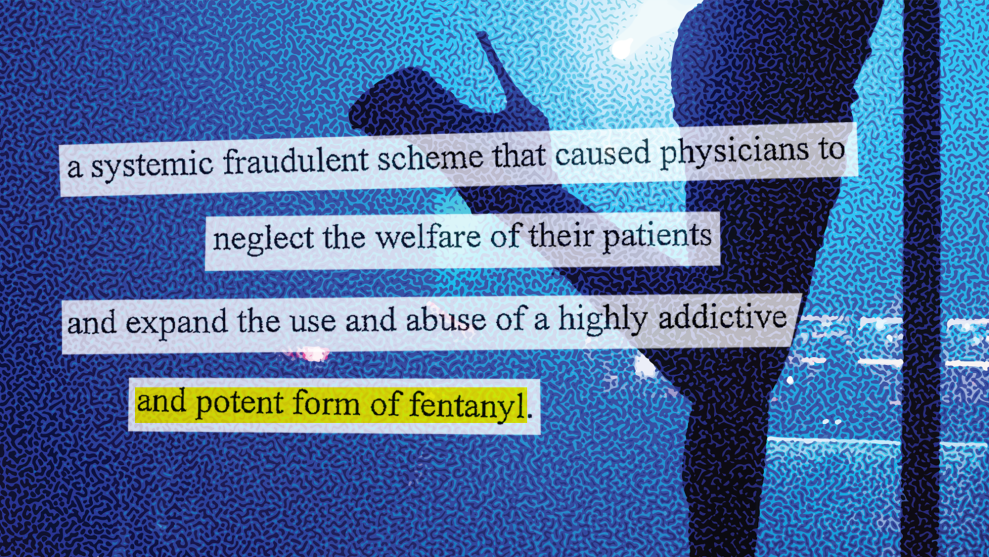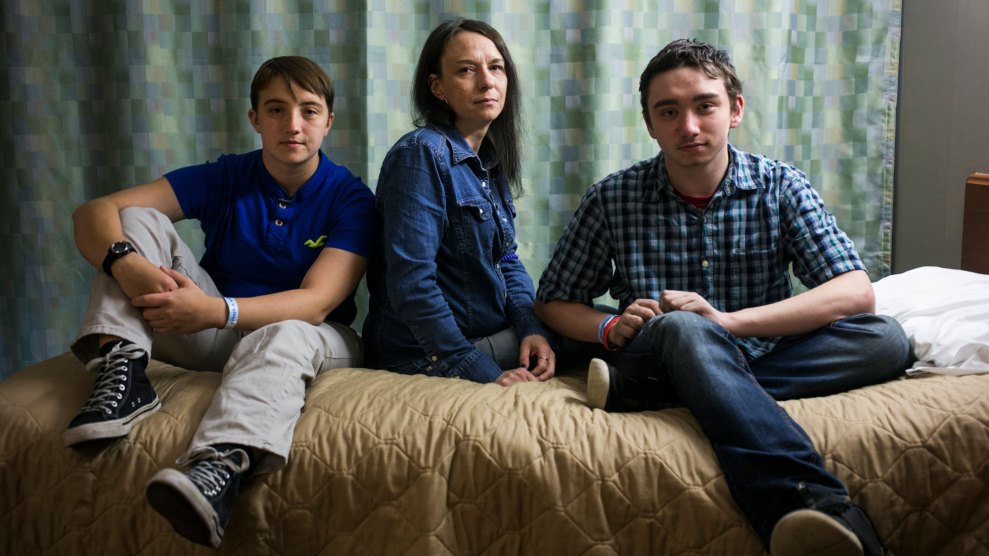
Mother Jones; GeorgePeters/Getty Images
Around 2015, just before overdoses sweeping the country started making national news, a pharmaceutical sales representative in New Jersey faced a dilemma: She wanted to increase her sales but worried that the opioid painkiller she was selling was addictive and dangerous. The medication was called Subsys, and its key ingredient, fentanyl, is a synthetic opioid 100 times stronger than morphine.
When the rep, who requested to go by her initials, M.S., voiced her concerns to her manager, she was told that Subsys patients were “already addicts and their prospects were therefore essentially rock-bottom,” according to a recently unsealed whistleblower lawsuit that M.S. filed after leaving Insys in 2016. To boost her numbers, the manager allegedly advised M.S. to “behave more sexually toward pain-management physicians, to stroke their hands while literally begging for prescriptions,” and to ask for the prescriptions as a “favor.”
These days, fentanyl makes headlines for driving the overdose epidemic: The opioid is often illicitly produced and mixed with heroin or other drugs. But Subsys, made by pharmaceutical company Insys, is one of a handful of potent, highly regulated prescription fentanyl brands specifically intended for cancer patients suffering from “breakthrough pain,” episodes of extreme pain that arise despite other painkillers the patients are taking around the clock. Since Subsys gained approval from the Food and Drug Administration in early 2012, Insys’ growth has been meteoric. In the spring of 2013, the company went public; by the end of the year, it was the nation’s best-performing IPO. By 2015, revenue from Subsys was approaching $500 million.
All the while, a handful of Insys employees were quietly filing whistleblower lawsuits, unbeknown to each other, alleging that the addictive drug was marketed to patients who suffered from all kinds of pain—not just cancer patients with breakthrough pain—and detailing dubious sales tactics: taking doctors to strip clubs, paying kickbacks for more prescriptions, posing as doctors’ representatives in order to get insurance to cover the drug. In the so-called qui tam lawsuits, whistleblowers file cases under seal on behalf of the US government, which investigates the allegations over the course of months or years as it decides whether to intervene and pursue a civil case.
In May, the Department of Justice announced it was intervening, consolidating M.S.’s complaint with four other whistleblower cases filed between 2013 and 2016. The announcement resulted in the unsealing of the five complaints, opening the floodgates to hundreds of pages of court documents that offer a rare glimpse into the lengths that the pharmaceutical company went to market and sell Subsys.
Four of the complaints were filed by former Insys sales representatives (click for links to the full documents): Maria Guzman, Torgny Andersson, Christopher Connors, and M.S. (who filed under Jane Doe). The fifth was filed by Allison Erickson and Sara Lueken, who worked for a pharmacy benefits manager that processed Subsys insurance claims.
Meanwhile, the DOJ’s criminal investigation of Insys and its top executives is already underway: Last fall, seven of the company’s top executives were indicted on fraud and conspiracy charges, including founder and chairman John Kapoor, CEO Michael Babich, vice president of sales Alec Burlakoff, and regional directors Sunrise Lee and Joseph Rowan. The defendants pleaded not guilty and await trial in January 2019. Their lawyers declined to respond to the criminal or whistleblower allegations.
Mother Jones combed through the five whistleblower complaints, as well as the complaint filed this spring by the US government based on the whistleblowers’ allegations. Here are the highlights:
Strip clubs and shooting ranges
Insys employees took doctors to strip clubs, fancy dinners, parties, and shooting ranges “so that the doctor then returns the ‘favor’ to the sales representative by prescribing SUBSYS,” Guzman alleged. The US complaint details how such an exchange played out in 2013, when sales executives Burlakoff and Rowan took out Florida pain specialist Dr. Bart Gatz:
105. On or about January 18, 2013, Dr. Gatz was taken to a strip club in Scottsdale, Arizona by two Insys executives, Alec Burlakoff and Joe Rowan. The next day, Mr. Burlakoff texted a colleague, saying “Went fantastic last night. Bart and I got back around 4 am. He had to have had one of the best nights of his life.” Several days later, Dr. Gatz sent a text to Mr. Rowan stating, “Thank you for the best weekend in years! ! !”
106. Upon information and belief, Insys also provided Dr. Gatz with lavish meals and at least one trip to a shooting range. Upon information and belief, in 2012, Insys provided Thanksgiving dinners for Dr. Gatz’ entire office staff.
107. Since 2012, Medicare has paid over $3.3 million for Subsys that was prescribed by Dr. Gatz.
Around the same time, Burlakoff was working on upping prescriptions from Dr. Charles Huang, another Florida pain specialist. From Guzman’s complaint:
116. On or around August 18, 2012 Burlakoff sent a text message to Dr. Charles Huang (“Dr. Huang”) stating “I need to know if Paula [Dr. Huang’s girlfriend] would take a full time job working for me? I also could use a few Subsys prescriptions. We have not seen anything, I want to have some fun!!! Can’t do it w/o subsys scripts coming in at least once a day. Have Paula call me next week. Let’s make it like the old days, turn the subsys switch on please Dr Huang!! … We mean what we say,just need you too (sic) get it going strong.”
117. From on or about August 21, 2012 to August 22, 2012, Dr. Huang prescribed 60 units of SUBSYS.
118. INSYS hired Dr. Huang’s girlfriend, Paula, in or around fall 2012.
Gatz and Huang declined to respond to the allegations. Both continue to practice pain medicine in Greenacres and Lakeland, Florida, respectively.
Hire a sales rep “banging a doctor”
Sex appeal appears to have been a key tactic in driving up Subsys prescriptions.
In 2012, Insys hired a new sales executive: Sunrise Lee, a Florida escort service manager and former strip club dancer with no academic degree, according to Guzman’s complaint. Burlakoff allegedly defended the decision, claiming, “Doctors really enjoyed spending time with her and found Sunrise to be a great listener.” He added, “She’s more of a closer.”
The same year, Insys hired a dental hygienist with no pharmaceutical sales experience, reportedly “to have sexual relations with doctors in exchange for SUBSYS prescriptions,” according to Guzman’s complaint. Rowan, then a regional sales manager, reported that the new employee was “dumb as rocks, but that she was sleeping with another doctor and getting a lot of prescriptions out of him.”
In 2013, Rowan asked Guzman if she had any recommendations for an open sales representative position in Nashville. He reportedly said the representative “could be anyone as long as it was a doctor’s girlfriend, son or daughter.” If the individual were “banging a doctor, that would be perfect.”
“Pain is pain”
The Food and Drug Administration approved Subsys for a specific population: cancer patients suffering from breakthrough pain. Federal law prohibits pharmaceutical marketing for off-label uses, yet Insys’ marketing campaign centered on using the drug to treat pain in general, according to the US complaint. Guzman alleged that on a conference call with the Insys sales team, one often-praised representative demonstrated his technique for the others: “Pain is pain. It does not matter whether it is back pain or a migraine. Pain is pain and Subsys treats pain.”
Even though the FDA further specifies that Subsys can only be prescribed by physicians knowledgeable about how to treat cancer pain with opioids, sales reps were allegedly trained to target internists and pain management doctors, who were generally more open to prescribing the drug than oncologists. According to Connors’ complaint, “In almost every instance, the pain management specialists targeted by Insys’ sales representatives had no patients with cancer.”
Orders to market Subsys for off-label use to attract more patients came straight from the company’s top brass, according to the US complaint. Around 2014, Burlakoff, the VP of sales, allegedly told this to his team at a national sales meeting:
These [doctors] will tell you all the time, well, I’ve only got like eight patients with cancer. Or, I only have, like, twelve patients that are on a rapid-onset opioids [sic]. Doc, I’m not talking about any of those patients. I don’t want any of those patients. That’s, that’s small potatoes. That’s nothing. That’s not what I’m here doing. I’m here selling [unintelligible] for the breakthrough pain. If I can successfully sell you the [unintelligible] for the breakthrough pain, do you have a thousand people in your practice, a thousand patients, twelve of them are currently on a rapid-onset opioids [sic]. That leaves me with at least five hundred patients that can go on this drug.
Insys provided its sales representatives with a scripted pitch that was “designed to steer physicians into prescribing Subsys off-label,” according to Connors’ complaint. Burlakoff and Babich, the company’s CEO, regularly participated in role-playing training exercises for sales reps that would simulate conversations with physicians. Connors’ complaint includes an example of the scripted conversation, which, notably, never mentions cancer:
Sales Representative: “I know your time is money, so I’m not looking to waste it. I’ve been directed to deal with a specialist. We have a boutique drug that deals with your specialty, pain management. It is my understanding that the procedure in treating pain is to establish a baseline?”
Physician: “Yes.”
Sales Representative: “With that being said, what percentage of your patients have chronic pain?”
Physician: “60%”
Sales Representative: “This is good. My drug is looking for opioid tolerant patients. What percentage of your patients are experiencing breakthrough pain four times a day and are on other therapy?”
Physician: “A few”
Sales Representative: “These are the patients my drug wants to address. Oh, and there’s a bonus: we’ll take care of the managed care aspects of your patients [through our Internal Reimbursement Center]. If you’re willing, I would like to go in greater detail over dinner.”
Insys also perpetuated the myth that Subsys could be used regularly, rather than just for breakthrough pain, according to M.S.’s complaint. “The expansion to persistent pain raised revenues dramatically, as it led to the use of Subsys every four hours, independent of the scale of pain the patient felt at any given time,” it alleged. “Thus, Insys turned Subsys, an analgesic roughly 100 times as powerful as morphine, into a maintenance opioid, like OxyContin or Oxycodone.”
The off-label marketing campaign was a resounding success: An estimated 80 to 90 percent of Subsys is prescribed for off-label use, according to several complaints, from back pain to headaches. As Guzman’s put it, “It was so unusual for the team to actually see a patient with a cancer diagnosis that they would get excited.”
The “magic number”
According to the FDA, patients new to Subsys should start at the lowest possible dose—100 micrograms—and increase as needed. But higher doses were more profitable. As M.S.’s complaint put it, “INSYS sales managers lectured sales staff, repeatedly, that the key to making more money was successfully encouraging physicians and patients to use higher doses of Subsys. Quite simply, the higher the Subsys dose, the more revenue generated by INSYS and, therefore, greater sales commissions to be earned by Subsys’ sales representatives.”
Sales reps were trained to tell doctors and patients that the initial 100 microgram dose was ineffective “for all but 4% of patients,” according to M.S.’s complaint, and to convince physicians to double the entry dose so that patients could “feel the drug working,” according to Guzman’s. The average effective dose, the reps would say, was between 600 and 1600 micrograms, with the “magic number” typically around 800 micrograms.
The company circulated a daily email report of prescriptions below 400 micrograms “to serve as a list of doctors in need of ‘education’ from sales representatives on proper dosing,” M.S. alleged.
The reps were rewarded $500 to $800 for every patient that switched from other fentanyl brands to Subsys, according to M.S. When a sales rep successfully switched a patient from a high dose of Actiq, a competitor, to Subsys, Burlakoff sent an email congratulating the rep that stated “cha ching again!” for the more than $40,000 that Insys would make from the sale, according to Guzman.
“Does money talk to them?”
All four former Insys employees mentioned the company’s speaker program, which the US complaint summed up as “paid kickbacks to induce physicians and nurse practitioners to prescribe Subsys for their patients.” Many pharmaceutical companies market their product by paying well-respected doctors to educate other physicians about a drug or product. But Insys “speakers” didn’t seem to do much speaking: “Many of these speeches have been attended only by the prescriber’s own office staff, by close friends who attended multiple presentations, or by people who were not medical professionals and had no legitimate reason for attending,” reads the US complaint. “The events have often been held in expensive restaurants.” As sales VP Alec Burlakoff allegedly put it, the purpose of the speaker’s program was to “put money into the pockets” of doctors, according to Guzman’s complaint.
M.S. alleged that she was trained to target physicians who received the most money from other opioid makers—using numbers accessible on ProPublica’s Dollars for Docs database:
In sales trainings, INSYS taught sales staff to classify physicians according to their perceived willingness to receive money for prescriptions…INSYS sales managers taught sales staff to color code doctors, “green” being the most likely to accept kickbacks, “yellow” less so, and “red” unlikely, on the basis of personality traits. During [M.S.’s] field training, she learned to associate the likelihood of physicians becoming prescription writers with the dollar amounts attributed to them on propublica.org.”
The speakers were paid according to how much they prescribed, according to several complaints. As Burlakoff put it to Guzman in a July 2012 text message regarding two such speakers, “Don’t worry about Dr Banchik or Dr Vendrys’s speaking abilities. They do not need to be good speakers, they need to write a lot of Subsys.”
Six months later, Dr. Banchik, a Florida neurologist, seems to have fallen out of Burlakoff’s favor. “She doesn’t produce shit for units or dollars,” Burlakoff wrote in another text. Eventually, the talk about Dr. Banchik turned crude. From Guzman’s complaint:
INSYS also maintains a work environment in which the male-dominated executive and management team frequently sexually treat female doctors who fail to prescribe “enough” SUBSYS in exchange for their kickbacks from INSYS with blatant disrespect, best summarized in a text message from INSYS Vice President of Sales Alec Burlakoff, in a text message to [Guzman] regarding a female doctor in her territory: “She fuckn sucks kock mia! What else can I say! XOXOXO .. .I hate that stupid bitch – dr banchik! ! ! ! ! ! ! ! I want to jerk off in her fuckn face!”
Free fentanyl until insurance covers it
Before covering Subsys, insurers require authorization from a doctor confirming that their patient meets certain criteria. So the company created an internal unit called the Insys Reimbursement Center that would press insurers to cover the drug, often by falsely claiming that they were employed by the doctor prescribing Subsys or falsifying patient diagnoses, according to the US complaint. (Sen. Claire McCaskill released a blistering investigation into the company’s practice last fall.)
In cases insurers didn’t immediately approve Subsys, Insys had a practice of providing the drug for free until that changed. In the short term, the tactic was expensive for Insys, as Subsys was about $10,000 for a 30-day supply, according to Connors. But in the long-term, it paid off: Authorization was much more likely after Insys could tell insurers that the patient was already taking the drug. And by that time, the patient was likely already addicted. As M.S.’s complaint put it, “the patient would grow dependent on the medication during that time, ensuring a long prescribing relationship.”
Opioids in the mail
One of the largest dispensers of Subsys was a specialty, mail-order pharmacy called Linden Care, according to M.S.’s complaint. Sales representatives were encouraged to pre-populate patient paperwork specifying that Linden Care should be the default pharmacy, according to Guzman. The idea of sending fentanyl in the mail allegedly worried some doctors; it showed that the pharmacist hadn’t adequately trained the patient on storage and disposal of the drug, putting pets and kids at risk. But the pharmacy also allegedly dispensed Subsys contrary to the FDA’s standards, according to M.S., “distributing it at initial doses at least twice the FDA-approved limit, and dispensing it for use six times daily, 150% of the FDA-approved limit.”
According to Guzman’s complaint, one doctor expressed another concern in 2013: “Some of his patients had come into the pharmacy complaining that they had not even ordered SUBSYS but that it had arrived through the mail at their homes.” Guzman brought the complaint to Burlakoff, but Insys continued using Linden Care.
Linden Care closed in the summer of 2017 and could not be reached for comment.
The result: Overdose
The failed checks and balances came to a head in the case of a woman referred to as “Patient #1” in M.S.’s complaint. M.S. made regular visits to “Doctor #1’s” office, dropping off breakfast, lunch, or boxes of coffee about once a week in late 2014 and generally “attempting to convince the Doctor #1 to prescribe Subsys to one of her patients.” Soon, the doctor said she’d found a good fit: Though the patient didn’t have cancer, she had a number of ailments that put her in pain—degenerative disc disorder, fibromyalgia, and more—and she had been dependent on other opioids for years. A meeting was organized with the patient and M.S., who did as she was taught: She encouraged the patient to start at 200 micrograms, to use more if the pain persisted after a half hour, and to feel free to change her dosage without first contacting her physician. By January 2015, the patient was off to the races: The doctor wrote regular Subsys prescriptions, Insys’ reimbursement unit made sure the drug was covered, and Linden Care sent the fentanyl in the mail.
Fourteen months later, the patient’s boyfriend woke to find her dead on the bedroom floor. The death was ruled to be an accidental fentanyl overdose.
“These failures began with the first prescription Linden Care filled for Patient #1, and continued until her death, eighteen prescriptions and $250,544.62 in Medicare copayments later,” M.S.’s complaint reads. The overdose was illustrative of “unlawful marketing, sale, and dispensing of Subsys on a nationwide basis.”
“A completely transformed organization”
In response to the unsealed court records, Insys responded that the company “continues to have ongoing dialogue with the DOJ regarding this investigation” and has set aside $150 million, “which it expects to be paid out over five years in connection with this investigation.” Some things have changed: The company has shut down the Insys Reimbursement Center, and there’s been a lot of turnover. 90 percent of the company’s sales force was hired since 2015. According to the Insys statement, “As the company has documented in various public releases, today INSYS is a completely transformed organization, with a promising pipeline, a strong commitment to serving patients as well as an organizational culture of high ethical standards. Throughout this transformation, INSYS has learned from the past and remains committed to significant innovation and investment in R&D, which the company believes will result in improving the lives of many patients.”
Still, a visitor to the Subsys website today is greeted by a banner touting “Free Trial and $0 Co-Pay” for those with the Subsys Savings Card. The site reads, “Similar to a coupon, it can offer you free product and up to $1,000 off each additional prescription of SUBSYS fentanyl sublingual spray.”














